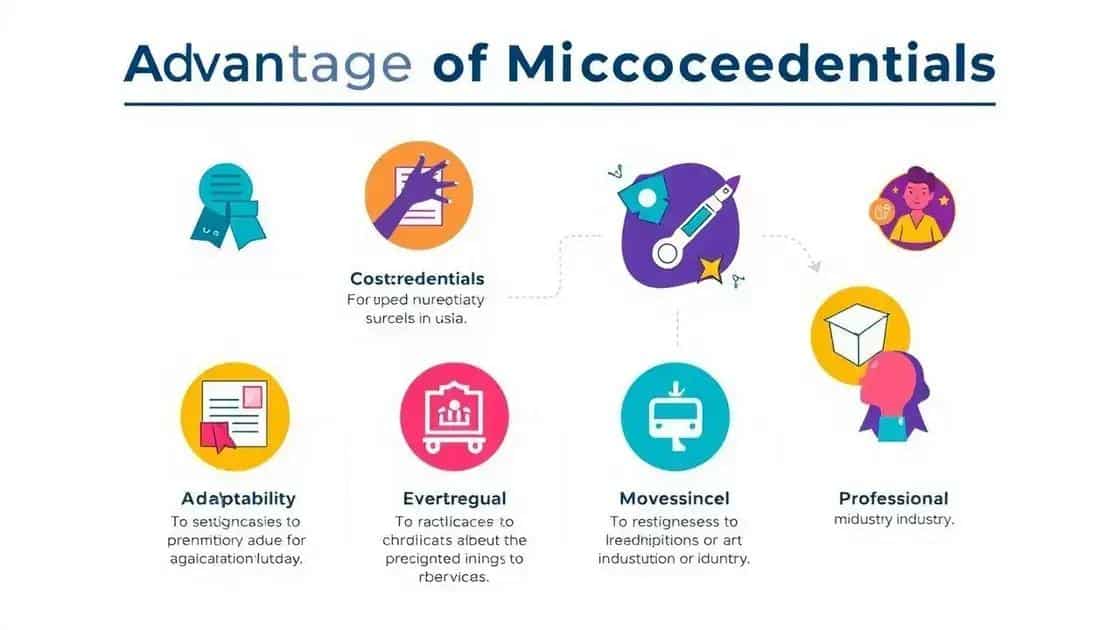Insights on microcredential education paths for career growth

Microcredential education paths provide targeted skills quickly and affordably, enhancing employability and industry recognition, making them essential for career advancement in today’s dynamic job market.
Insights on microcredential education paths can open doors to exciting career advancements. Have you considered how these programs could reshape your professional journey?
Understanding microcredential education
Understanding microcredential education is crucial for anyone looking to enhance their skills in today’s competitive job market. These programs provide an efficient way to gain knowledge and credentials without the need for a full degree. They are flexible, allowing learners to balance their education with work and personal commitments.
Microcredentials are short, focused courses that help individuals learn specific skills or concepts. Unlike traditional education, they can be completed in a matter of weeks or months, making them an attractive option for busy professionals. Many industries recognize these credentials as valid qualifications, enhancing employment opportunities.
Key features of microcredential education
Microcredential programs often have several defining characteristics:
- Focused learning objectives, concentrating on specific skills.
- Short duration, allowing for quick completion.
- Affordability, costing less than traditional degree programs.
- Industry recognition, providing credibility to employers.
These features make microcredential education an appealing option for many learners. As the workforce evolves, the demand for skills-based education continues to grow. Many students are turning to microcredentials to bridge the gap between their current expertise and the skills needed in their desired careers.
Institutions are also responding. An increasing number of colleges and universities are offering microcredential programs to meet this demand. This trend indicates a shift in educational paradigms, prioritizing skill acquisition over traditional degree attainment.
The benefits of microcredential education
Several benefits come with pursuing microcredentials, such as:
- Enhanced employability, giving learners a competitive edge.
- Opportunities for career advancement, leading to promotions and new roles.
- Networking possibilities, connecting learners with industry professionals.
- Customization, allowing learners to tailor education to their specific career goals.
As individuals contemplate their educational paths, understanding microcredential education is essential. This knowledge empowers them to make informed decisions about their careers and the skills they need to succeed.
Benefits of pursuing microcredentials

The benefits of pursuing microcredentials are becoming more apparent as the job market shifts. These educational pathways offer a unique approach to gaining valuable skills that can enhance your career. They allow individuals to focus on specific areas of interest or jobs, helping them stay relevant in an ever-changing workforce.
One of the primary advantages is the ability to boost employability. Employers are increasingly seeking candidates with specialized skills, and microcredentials can provide that edge. Unlike traditional degrees, these programs can often be completed quickly, enabling learners to gain qualifications and enter or advance in their desired fields sooner.
Key advantages of microcredentials
Some important benefits of pursuing microcredentials include:
- Flexibility in learning, allowing you to study at your own pace.
- Cost-effectiveness compared to traditional degree programs.
- Industry recognition, which can strengthen your resume.
- Networking opportunities, connecting you with peers and industry experts.
Another significant benefit is the customization they offer. Learners can select courses that align closely with their career goals, creating a tailored educational experience. This focused approach enhances both knowledge and skills pertinent to specific industries, leading to more meaningful job prospects.
Additionally, many microcredential programs are designed in collaboration with industry leaders. This ensures that the curricula are relevant and up-to-date, making graduates more appealing to employers. As a result, microcredential earners often have higher success rates in finding jobs or advancing in their current roles.
Long-term career growth
Pursuing microcredentials can lead to significant long-term career growth. This is particularly true in sectors that value continuous learning and adaptation. By constantly updating and enhancing your skill set, you can increase your chances for promotions and leadership roles.
Overall, the benefits of pursuing microcredentials are vast. They provide opportunities for quick skill acquisition and career enhancement. As more professionals recognize their value, microcredentials are likely to play a larger role in education and employment.
How to choose the right microcredential
Choosing the right microcredential can be a pivotal step in advancing your career. It is essential to consider your personal and professional goals when selecting a program that fits your needs. By aligning your choice with your aspirations, you can ensure that your investment in education pays off.
Start by assessing your current skills and identifying the areas you want to improve. This reflection will guide you in selecting a course that complements your experience and helps you work towards your career objectives. You can then explore various options that align with these goals.
Factors to consider
When choosing a microcredential, consider the following factors:
- Industry relevance: Ensure the credential is recognized by employers in your field.
- Course content: Review the curriculum to see if it covers the skills you wish to learn.
- Flexibility: Look for programs that allow you to study at your own pace, making it easier to balance your education and personal life.
- Cost: Assess the program’s cost against your budget and potential return on investment.
In addition to these factors, research the institution offering the microcredential. Established organizations often lend credibility to the education you receive. Furthermore, reading reviews and testimonials can provide insights into the experiences of past students.
Another essential aspect is the support provided during the course. Check if there are resources like mentorship, networking opportunities, or forums for discussion, as these can enhance your learning experience.
Making the final choice
After gathering all this information, narrow down your options. Create a shortlist of programs that resonate with your goals and preferences. Reach out to advisors or alumni for additional insights, as their experiences can help clarify your decision. Finally, trust your instincts when choosing the microcredential that feels right for you.
By following these steps, you will be well-equipped to make a confident decision about the right microcredential for your personal and professional development.
Future trends in microcredentialing

Future trends in microcredentialing are shaping how individuals approach education and career development. As the demand for specific skills increases, the landscape of learning continues to evolve. Microcredentials are becoming more popular, allowing people to acquire necessary skills quickly and efficiently.
One major trend is the integration of technology into microcredential programs. Online platforms are making it easier than ever to access courses from anywhere in the world. This flexibility is appealing to learners who need to balance education with work and personal commitments. As technology advances, these programs will likely become even more interactive and engaging, providing immersive learning experiences.
Growing industry recognition
Another trend is the growing acceptance of microcredentials by employers. Many companies are starting to value practical skills over traditional degree qualifications. As more employers recognize the credibility of these short courses, the relevance of microcredentials will continue to rise in the job market.
- Expanded partnerships between educational institutions and industry leaders.
- Development of competency-based assessments to measure learner skills.
- Increased focus on personalized learning pathways.
- Wide variety of microcredentials tailored to niche industries.
As microcredentials gain traction, it is essential for institutions to provide a diverse range of options that meet industry needs. This will ensure that learners can choose pathways that align with their career goals. Moreover, partnerships between schools and employers can create programs that provide real-world applicability.
Impact of lifelong learning
The emphasis on lifelong learning will further influence the future of microcredentialing. As industries evolve, workers will need to continually update their skills to remain competitive. Microcredentials offer a viable solution for those looking to enhance their knowledge and adapt to changing market demands.
In conclusion, future trends in microcredentialing point towards increased accessibility, industry recognition, and the importance of continuous learning. By staying informed about these developments, learners can better position themselves for success in a rapidly changing job landscape.
FAQ – Frequently Asked Questions about Microcredentialing
What is microcredentialing?
Microcredentialing is a form of certification that recognizes specific skills or competencies gained through short, focused courses.
Why should I pursue a microcredential?
Pursuing a microcredential can enhance your employability by providing you with targeted skills that are increasingly valued by employers.
How do I choose the right microcredential program?
To choose the right microcredential program, consider factors such as industry relevance, course content, flexibility, and cost.
Are microcredentials recognized by employers?
Yes, many employers are starting to recognize and value microcredentials as a legitimate way to demonstrate specific skills.





